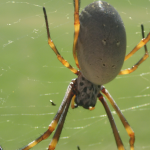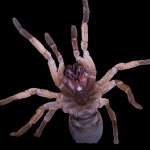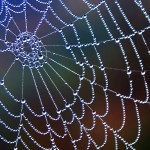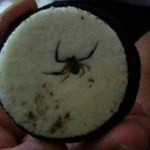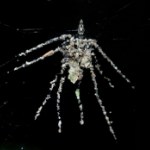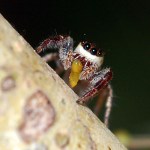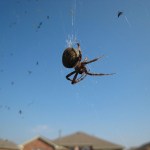spider
Photo by Mike Blyth via Flickr Commons
Surfactant is a lipoprotein substance that is secreted by special cells located in the alveoli of our lungs. The alveoli are the grape-like structures where gas exchange happens. Without surfactant, these alveoli would collapse and prevent gas exchange.
Drawing of alveoli by Patrick J. Lynch, medical illustrator (Patrick J. Lynch, medical illustrator) CC BY 2.5 via Wikimedia Commons
Babies born prematurely often suffer from respiratory distress syndrome because their lungs do not make enough surfactant. Now researchers at the Karolinska…
A new study shows that globally, spiders consume 400-800 million tons of prey each year. That's roughly more than double the amount of fish and meat that humans consume. Impressive...yet creepy at the same time. I suppose we should thank them for their pest control efforts.
Sources:
M Nyffeler, K Birkhofer. An estimated 400–800 million tons of prey are annually killed by the global spider community. The Science of Nature. 104: 30, 2017. doi:10.1007/s00114-017-1440-1
News Beat video from YouTube
Happy Halloween!
The day just would not be complete without goblin spiders. Check out this neat YouTube video I came across describing species found in Ecuador.
Research published July 3 in the journal BMC Evolutionary Biology supports the idea that some species of spiders can catch the wind to "sail" across bodies of water, which they suggest might be why certain spiders seem to be all over the world. While some spiders were already know to catch the breeze to travel by air relatively short distances, and some are known to be aquatic, the researchers in this study were interested in examining just how well spiders could actually walk on water. So, they collected 325 wild spiders and dropped them on water to see what…
I really never thought of spiders as being "pretty" until I came across these two new species of peacock spiders discovered in southeast Queensland, Australia by Madeline Girard (graduate student from the University of California, Berkeley, who is specializing in peacock spiders). Peacock spiders are not only beautiful, they also engage in elaborate dances during courtship.
According to a quote from Jürgen Otto (posted in Live Science), who was a co-author in the study, Skeletorus "looks dramatically different [from] all other peacock spiders known to date, making me think that this…
A new study from researchers at the University of Sydney shows that golden orb-weaving spiders (Nephila plumipes) that live in the city are larger and produce more offspring as compared to country living.
When they say the spiders are big, they mean really big. The females can reach up to 20-25mm (males are only ~5mm).
Image from Spiders of Australia http://ednieuw.home.xs4all.nl/australian/nephila/Nephila.html
The researchers speculate that the urban heat island effect, which is attributed to a lack vegetation and hard surfaces, may lead to the increased body size as invertebrates in…
Photo credit: Margaret C. Hardy
Drs. Glenn King and Maggie Hardy at the Institute of Molecular Bioscience, University of Queensland, Australia have discovered a small protein, aptly named orally active insecticidal peptide-1 (OAIP-1), in the venom of Australian tarantulas (Selenotypus plumipes) that can kill prey when ingested orally. According to the study, OAIP-1 is fast acting and more potent than commercial pyrethroid insecticides and is very effective at killing the agricultural pest, cotton bollworm. The authors suggest that OAIP-1 may therefore be useful as a bioinsecticide.…
Image of wet spider web from www.photoforum.com
The US Navy has decided to sponsor research conducted by Dr. Randy Lewis, a specialist in spider silk, at Utah State University. Their interest in the research lies in the ability for spider silk to maintain adhesiveness even under wet conditions. Therefore, Navy officials are seeking to create a synthetic spider silk that they can manufacture for use as an underwater adhesive.
Source:
Utah State University
"If I see a spider in my house, I put it in a cup, and then I take it outside. I save it. What is wrong with me?" -Jacqueline Emerson
There's something not only incredibly useful but also beautiful about the intricate structure of a spider web. It's such a universally admired phenomenon that it's become a metaphor for many other things, as Welbilt sings you in their song,
Spiderweb.
Dependent on the type of spider and various environmental factors, the web can take on any number of beautiful shapes.
Image credit: Darlyne Murawski, via National Geographic Society, 2007.
Image credit:…
You know about the Atheists Nightmare, right? Also known as the Evolutionists Nightmare. No? It goes like this:
That's pretty darn convincing. Until someone opens up some closed thing and there is some new species in there, then EVOLUTION IS MADE UP!!!1!!!
Well, it turns out, Evolution is True. Some guy on the internet opened up an Oreo Cookie and inside was a new organism that could only be there IF IT EVOVED IN SIDE THE COOKIE!!1!! Look here's a picture:
PROOF THAT EVOLUTION IS TRUE: This spider evolved inside this Oreo Cookie!
A fake you say? A falsehood you say? Sorry, but Snopes…
Check out this "sculpure" of a spider discovered by Biologist Phil Torres, created by what may be a new species of Cyclosa found in the Peruvian Amazon. This is not just a pattern weaved by the spider into the web, but instead it is created from debris in the forest (dead insects, leaves, etc.). It is believed the spiders use the sculptures to confuse predators. The real spider can be spotted in the second image below just above the fake spider. In this location, the real spider can actually shake the fake spider to make it appear alive.
Spider sculpture (image credit: Phil Torres,…
This is a must-see special from NOVA highlighting nature's secret to creating very strong things: like the beak of a toucan, an abalone shell and a spider's web. It aired last night on PBS (premiered Jan 2011) and I found myself glued to the TV. Scientists are working hard to try to re-create some of nature's amazing strength to help improve existing technologies. One that I found amazing: scientists have been able to create genetically modified sheep to mass produce spider silk, which is reportedly stronger than kevlar!
Watch Making Stuff: Stronger on PBS. See more from NOVA.
If you…
Megarachne, (changed to Mesothelae for broadcast) restored as an enormous spider in the series Before the Dinosaurs: Walking With Monsters.
Imagine that you are are standing in a massive junkyard with the remains of cars strewn all about you. A few are relatively complete, but most of the heap is made up of bits and pieces of models from the entire history of automotive innovation. If you were to reach down and pick up one of the scraps, would you be able to tell the make and model of the car it came from?
The challenges a paleontologist faces in reconstructing the life of the past are…
In East Africa lives a species of spider that drinks mammalian blood. But fear not - Evarcha culicivora is an indirect vampire - it sates its thirst by preying on female mosquitoes that have previously fed on blood themselves.
Even though its habitat is full of non-biting midges called "lake flies", it can tell the difference between these insects and the blood-carrying mozzies it carries. Robert Jackson from the University of Canterbury discovered this behaviour a few years ago and one of his colleagues, Fiona Cross, has now found that the blood isn't just a meal for the spiders, it's an…
In the forests of South Africa lurks an arachnophobe's nightmare - Nephila kowaci, the largest web-spinning spider in the world. The females of this newly discovered species have bodies that are 3-4 centimetres in length (1.5 inches) and legs that are each around 7.5cm long (3 inches).
This new species is the largest of an already massive family. There are 15 species of Nephila - the golden orb weavers - and at least 10 of them have bodies that are over an inch long. Many spin webs that are over a metre in diameter.
The first of these giants was discovered by Linnaeus himself in 1767 and…
In a surprise discovery, scientists have discovered the first known mostly vegetarian spider in the jungle mountains of Costa Rica and Mexico. The Bagheera kiplingi was observed feasting not on flies or gnats but on the buds of the acacia plant. Science has known about the Bagheera kiplingi since the late 1800's when naturalists collected dead specimens of them. This is the first time, however, that its behavior was logged.
Um, excuse me. There isn't any gelatin in this plant bud, is there?
Christopher Meehan of University of Arizona in Tucson studied the spiders (while at Villanova),…
In Latin America, there lives a unique spider called Bagheera kiplingi. It's a jumping spider and it shares the group's large, acute eyes and prodigious leaping ability. But it also has a trait that singles it out among all 40,000 species of spider - it's mostly vegetarian.
Virtually all spiders are predators. They may hunt using different methods but they all end up sucking the liquidised innards of their prey. If they consume plants, they do so rarely, even accidentally. Some take the odd sip of nectar to supplement their diet of flesh. Others accidentally swallow pollen while recycling…
The leading spider scientists have long been flabbergasted by two things: 1) Why they aren't swimming in women with their own condominiums and 2) why some spiders seem to cover their otherwise see-through webs with junk. The scientists may now have an answer to question two, the one that, unfortunately, does not add to their genetic fitness. It appears as if spiders put leaves and other forms of organic garbage on their webs in order to fool predators into believing that the junk is in fact them, sitting in wait.
It's my web and I'll do what I damn well please with it.
A new study found on…
It's been just three weeks since I last wrote about the dark-footed ant-spider Myrmarachne melanotarsa, but this is one species that just keeps getting more and more interesting. To quickly recap, M.melanotarsa is a jumping spider that protects itself from predators (like other jumping spiders) by resembling an ant. Earlier this month, Ximena Nelson and Robert Jackson showed that they bolster this illusion by living in silken apartment complexes and travelling in groups, mimicking not just the bodies of ants but their social lives too.
Now Nelson and Robert are back with another side to the…
The animal world is full of harmless liars, who mimic species more dangerous than themselves in order to avoid the attention of predators. But none do it quite like the dark-footed ant-spider Myrmarachne melanotarsa.
As its name suggests, this small species of jumping spider, discovered just nine years ago, impersonates ants. In itself, that's nothing special - ants are so aggressive that many predators give them a wide berth and lots of species do well by imitating them. The list includes over 100 spiders but among them, M.melanotarsa's impression is unusually strong. It doesn't just mimic…

